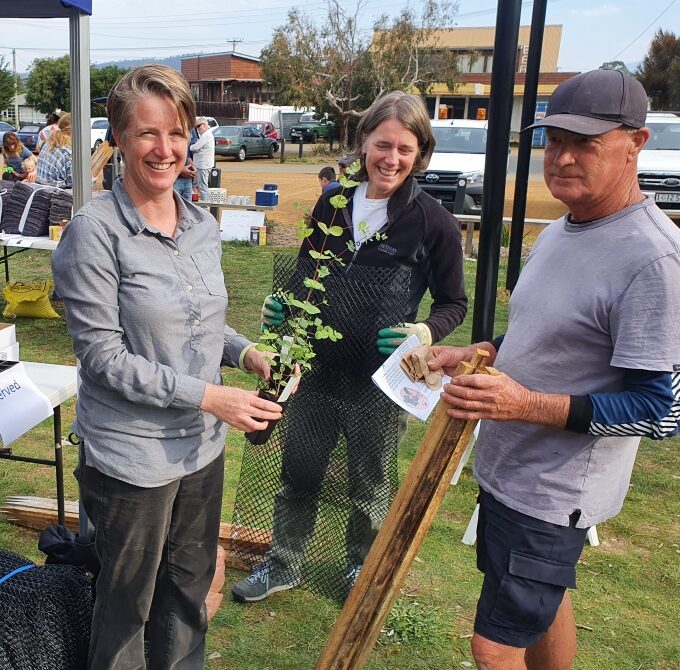Tasmania is home to 30 species of eucalypt, 16 of which are found no-where else on Earth. One of these Tasmanian endemic species is Morrisby’s gum (Eucalyptus morrisbyi), an endangered tree and amongst the 30 priority plant species listed in Australia’s Threatened Species Strategy. Work on this rare gum, undertaken as part of NRM South’s threatened plants project, aims to bring this species back from the brink of extinction. Through a partnership project with Enviro-dynamics, work has been started on a suite of actions that will help to halt this downwards trend.
Morrisby’s gum is found at two locations in Tasmania’s south-east and today there are only a few remnants of Morrisby’s gum left in the wild. These wild stands have suffered a significant decline in recent years, going from around 2,000 mature trees in 2006 to fewer than 50 now. This population decline is being driven by factors such as climate change, increasingly dry conditions, and insect and browser attack.
Enviro-dynamics, a Hobart based environmental consultancy and key project partner, has been leading delivery for the project, including on-ground actions such as a community planting initiative aimed at boosting Morrisby gum numbers and improving genetic connectivity between remnant populations across the landscape. In March 2021, Enviro-dynamics put a call out to landholders in the South Arm region – a narrow peninsula that hooks into the Derwent River and is within the natural range of Morrisby’s gum – inviting them to be involved in a revegetation project to establish plantings in priority areas.

A letter drop to 300 locals along with local and social media promotion evoked a great response from the community and a high demand for seedlings. Magali Wright is a botanist and threatened plants specialist at Enviro-dynamics who has been working on actions to protect Morrisby’s Gum since 2012. She uses an approach of community awareness – combined with collaboration between management organisations – as a strategy to reduce some of the more manageable pressures on Morrisby’s gum and improve conservation outcomes.

Our hope is that working directly with locals to plant seedlings in the tree’s known range will help to increase community awareness of the species plight and their involvement in conservation efforts. The seedlings we have given to landholders as part of our community engagement work have been grown from the seed maintained by the Tasmanian Seed Conservation Centre based at the Royal Tasmanian Botanic Gardens. We are also working to increase these seed resources, so that they can help support future conservation plantings both in the known range of the species and its future climate range.’ – Dr. Magali Wright
PROJECT HIGHLIGHTS TO DATE
- A community engagement event, in collaboration with the Cremorne Coastcare group, where Morrisby’s gum seedlings, planting and tree care advice were given to the local community
- 174 plant giveaways have contributed to 21 new plantings, ranging in size from 1 to 40 plants
- Development of a factsheet on how to plant and look after Morrisby’s gum
- Previously unknown established plantings were discovered through site visits and community engagement. These plantings are up to 45 years old – with the largest containing 15 trees,
- Technical advice on the planting and care of Morrisby’s gum has been provided to over 45 people, some of whom will undertake plantings in 2022 and 2023
The conversations that Magali and the Enviro-dynamics team are having with the community are not only raising awareness of the species but also helping to inform future conservation efforts with analysis of the newly discovered plantings providing useful information that will help in the design of future plantings.
‘Of the older plantings that we came across, we found some are growing well and have produced seedlings. On the other hand, some others have failed to thrive, or have even died up to 20 years post establishment. These observations and the information they provide helps improve our understanding of what to look out for when selecting planting sites.’ – Dr. Magali Wright


As well as the community planting initiative, other actions being carried out as part of this project include protecting remaining plants from native mammal browsers, wildfire and extreme hot and dry conditions, improving genetic connectivity of remnants, establishing new plantings in the modelled future climate region of the species and building up genetically diverse seed bank reserves.
The project still will run until June 2023 and we look forward to the positive impact it will have for the future of Morrisby’s gum.
The project is supported by NRM South through funding from the Australian Government’s National Landcare Program. It is being delivered in partnership with Enviro-dynamics, the Tasmanian Parks and Wildlife Service, the University of Tasmania, the Tasmanian Seed Conservation Centre, the Royal Tasmanian Botanical Gardens, DPIPWE’s Threatened Species Section and the Understorey Network. Thanks also to Clarence City Council and pakana Services for their involvement.
Click here for a pdf copy of this case study.
Image credits: Enviro-dynamics

